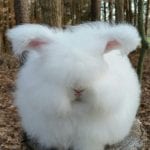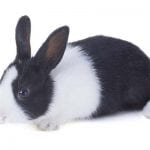Scientific Facts
| Common Name: | Harlequin rabbit |
| Scientific Name: | Oryctolagus cuniculus |
| Life Span: | 5 to 8 years |
| Size (Adult): | Medium to large |
| Weight (Adult) | 6.5 to 9.5 pounds |
| Habitat: | Human homes, yards, gardens, and fields |
| Body Shape: | Commercial |
| Country of Origin: | France |
Physical Description
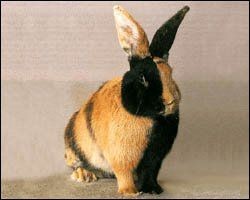
The harlequin rabbit is a very colorful rabbit breed that originated from France. It was named the harlequin rabbit based on the colors and the marks rather than the body type and fur. The weight of an adult harlequin is 6.5 to 8 pounds.
Harlequin rabbits are known to have a part black or some other color and another part white or orange. The brighter the orange color, the better. The coat should have a mix of both colors and with possible half and half design on the head. The color and not the name of the breed may also be referred to as magpie, where the second hue is white rather than the traditional orange.
The recognized color combinations are black, blue, chocolate brown and lilac mixed with orange. Meanwhile, the magpie varieties include black, blue, chocolate brown, and lilac. The harlequin is recognized by the American Rabbit Breeders Association or ARBA and the British Rabbis Council or BRC.
The harlequin rabbit has two types: Japanese and magpie. The Japanese harlequin has orange and black, chocolate, blue or lilac. The magpie variety is white rather than orange and maybe black, blue, lilac, or chocolate. The ideal harlequin must be a split between the two hues along with the head, feet, body, and ears. There must be a perfect shine on the colors. Some harlequins have a white or orange belly.
Harlequin rabbit based on ARBA standards

The current standard of perfection for the harlequin from ARBA calls for a three-part frontal alteration. The ears must have two different colors while the face splits into two colors and alternate between the ears.
The chest and the front legs should be a split of two colors that alternate with the color of the face and should match the ears. The rabbit’s hind feet must alternate with the front feet. There could be body markings like bands or bars or a combination. A harlequin rabbit may be disqualified from the event if it lacks the face markings.
Some say that this is not a rabbit breed but just a color combination or a color type. Some say that this is a color scheme for a rabbit breed. Actually, the color combination of the harlequin rabbit may be seen in other breeds, but the ARBA does not recognize these colors on other breeds only on the harlequin breed.
History of the Breed

The harlequin rabbit breed was developed from a captive wild Tortoiseshell Dutch Rabbits. This breed initially looked like a badly-colored and marked Dutch rabbit, but soon, the marks and colors were recognized as a unique characteristic of the harlequin.
The harlequin rabbit was first unveiled in Paris in 1887. After a few years, this breed was imported to England and was used for its meat during World War II. The name harlequin was adapted from the appearance of a court jester. The original name was Japanese rabbit, but it was not used during World War II.
Fast Facts
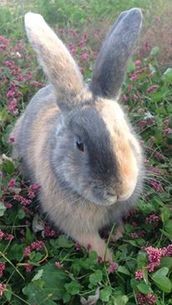
Do you know that a perfect harlequin is split between two colors on the rabbit’s head, feet, ears, and body? It is one of the trickiest rabbits to judge in a competition because judges need to meticulously examine the rabbit for all its color combination. A show judge can be very ruthless and may disqualify a harlequin because of a small color mistake like a mismatched hind leg.
But don’t worry about harlequins that don’t pass these tough show screenings because this rabbit breed is still friendly, affectionate, playful, and active. These will make good pets for families, first-time pet owners, and seniors, and singles.
Reproduction
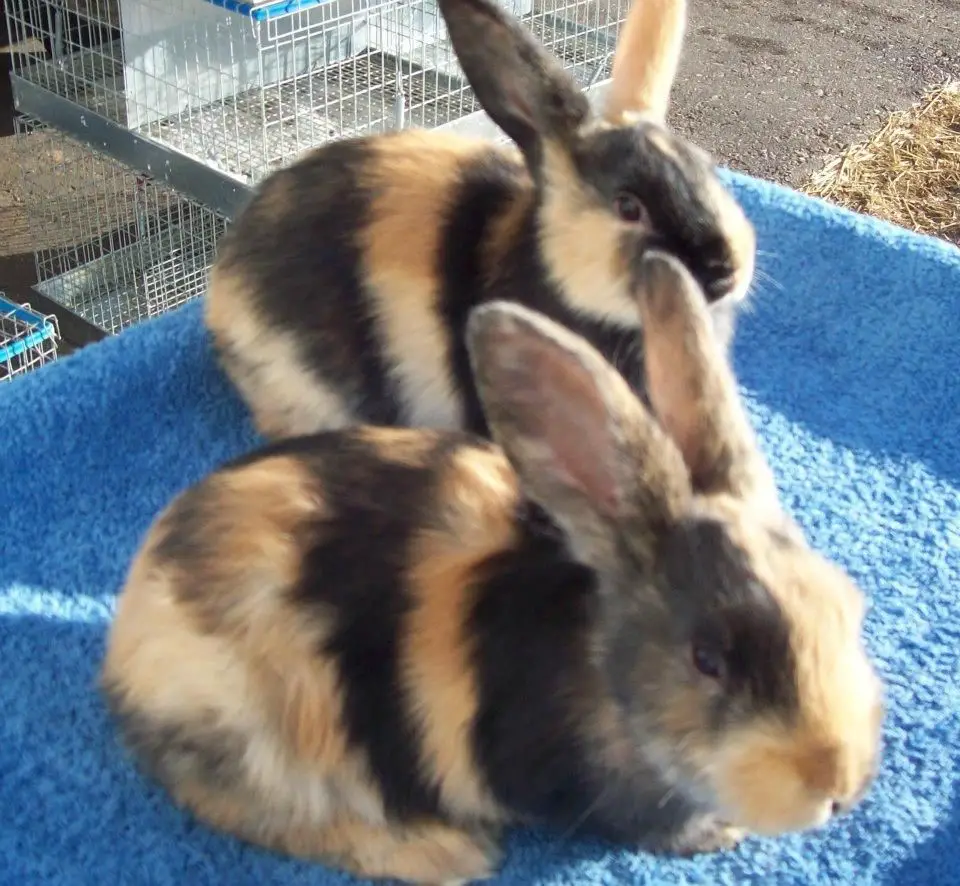
3If you plan to breed harlequin rabbits for show or competition, you need to learn how to expertly breed rabbits and identify the traits and especially the colors you want the offspring to have. It is important to consider color, color patterns, and markings at this point before you proceed.
But if you’re breeding for pets, you don’t need to be worried about color patterns and combinations. All you need is a healthy doe and a healthy buck.
Rabbits like the harlequin rabbit are ready to mate in just a few months after birth. A male is usually inside his cage, and the female is placed inside to introduce them. The female will initially remain still as the male sizes her up. He may sniff her occasionally, and the female may either be receptive or not.
If the female is receptive, she will lay down and let the male sniff her and mount her. She will also remain still as he thrusts his hips into her. But if a female is not receptive and does not want to give in, she will play hard to get and will let the male chase after her.
The two will run about, and sometimes the female will stay still, and the male may mount her. She may run away again, but the male is relentless. Soon, she will also give in and let the male mount her. The buck will thump his legs as a sign of mating success. The breeder will remove the male from the cage, or the female will have her cage where she will make her nest.
The gestation period is up to 35 days or sometimes shorter or longer. It’s obvious that she is about to give birth when she starts to look for a place to build her nest and when she loses interest in eating and drinking. At this time, the breeder places a nesting box filled with hay. The doe will arrange the box so that the hay will be lined and ready. Like other rabbits, the harlequin may also use her fur to build her nest.
She will lay down and remain in the nest for a day to give birth. The babies are born deaf, blind, and naked. The mother will remain in the nest only for a short time and will return nightly to feed her babies. She returns night after night but will leave her babies well-covered by hay and other material to protect them from predators.
The babies will develop fur in three days and can open their eyes in a few more days. These will soon leave their nest on the tenth day. Rabbits become mature in just a few weeks. Does can become pregnant as soon as she delivers.
Fun Facts

The harlequin rabbit is also known as the clown of rabbits because of their unique color combinations and the markings on their bodies. Is it safe to say that there are no two harlequin rabbits that look alike? No, some harlequins look very much alike, and this usually in families or siblings.
Personality and Behavior
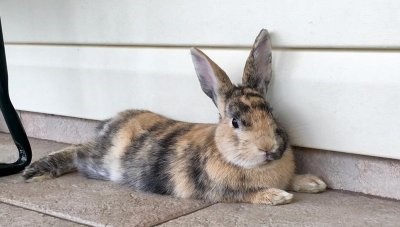
Harlequins are very curious animals. They will spend a lot of time inspecting and exploring parts of their cages or enclosures even if they’ve done it a million times before. These rabbits are always on the lookout for places to escape too, so always check the stability of its cage and any rips or tears of the cage’s screen. If you see one, fix this before it’s too late.
Harlequins are big babies. Because of their friendliness and ease of training, it is easy to gain the trust of harlequin, and thus, it can be carried and petted like a baby. It is a medium to large rabbit breed, but nonetheless, it will allow you to you carry it like a baby wherever you like.
It easy to train, and you can use food or treats to catch its attention. It can learn how to come when called and also to potty train. To train to come when called, sit in front of the rabbit and hold food or treats in your hand. Place some treats on the floor and let it move to you and eat the treats. Once it eats the food and moves closer to you. Reward it for climbing on your hand. Give it treats and food and of course, a lot of pats. Do this every day, and soon, it will gain your trust and will come to you even without treats.
Teaching how to potty is a harder trick, but no doubt, it’s possible. Just place several litter boxes in different areas in your home. Rabbits usually associate the area where it poops by the scent it leaves. Place the boxes in areas where the rabbit regularly poops and reward the rabbit for using the litter box.
Harlequin rabbits are social animals, and thus, it will love being with other rabbits of the same breed. Therefore, if you plan to take a harlequin home as a pet, consider taking two, three, or more rabbits as companions. Breeders say that rabbits can become lonely, and this is true for any rabbit.
Rabbits can eat their young, and although some experts are still unsure why the rabbit does this, they think that it may be due to having poor nutrients and water inside the cage, or it could be a natural way to defend its nest from predators. The mother will also eat the blood and tissues of stillborn babies to avoid predators.
Care of Harlequin Rabbits
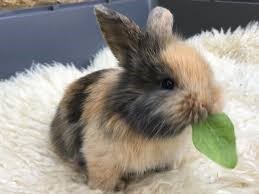
Caring for a pet Harlequin Rabbit is the same as caring with other rabbit breeds. To ensure that your pet is healthy and happy, make sure that it has the correct food, a safe and secure cage, companionship, and proper medical treatment.
The most important part of a captive rabbit’s diet is hay. Hay is the bulk of a rabbit’s diet, but you may also feed it pellets designed specifically for rabbits. Commercially-prepared food comes with added nutrients like vitamins and minerals for proper health. You may also serve vegetables and fruits to create a well-rounded diet, especially for young rabbits.
Provide them unlimited fresh water and hay. Hay helps keep their digestive tracts healthy and regular. Place the water in a large, heavy dish so that your rabbit can easily drink from it. A heavy dish is essential, so your rabbit won’t knock it over as it moves inside the cage. You may also place water in an inverted bottle with a spout so your pet can easily drink.
Feed only organic fruits and vegetables to protect your rabbit from pesticides, toxins, and herbicides. Younger rabbits need alfalfa hay because this is rich in calcium for growing bones. The adult Harlequin Rabbits may be fed legume hay. Remember, don’t just give any yard clippings to your pet because some of these may not be good for your pet. Check if it is safe to eat by consulting your vet.
Captive-bred Harlequin Rabbits can become a well-trained and friendly pet, but you need to train it daily. Interact by playing with your pets regularly. Rabbits are social animals and need human interaction and socialization with their cage mates. Experts say that captive-bred rabbits thrive well because they interact with their owners daily.
Harlequin rabbits will groom themselves, and sometimes it can take hours cleaning itself, taking extra time grooming under the feet and ears. Rabbits may also clean each other, which is a social behavior as a way to bond with their cage mates. Mother rabbits may also groom their young as they are still together in the nest.
Harlequin rabbits are active during the day and will sleep during nighttime. Their feedings must be given in the morning when they are most active. Captive rabbits may sleep up to 8 hours a day, on average, and they may sleep, huddled together inside the cage to keep each other warm and safe.
Supplies and Cages

The cage or enclosure should be made of wire with a strong frame. Remember, your pet is large, and he can easily knock the fence down if it wants to escape. The bottom must have a removable plastic pan or tray where the droppings will easily fall. The floor of the cage must have soft bedding so that it is comfortable and warm for your pet or pets.
Install a rabbit hay feeder on the side of the enclosure so your rabbit can eat hay when it feels hungry. For the bedding, you may use hay or aspen, wood pellets, or horse bedding.
The cage should be cleaned once a week or twice a week. Remove your pet/pets and clean it with a safe cleaner or natural cleaning product such as baking soda, white vinegar, or lemon juice. Do not use common household cleaners, which may have toxic ingredients that can be toxic for your pet.
Take note that baby Harlequin Rabbits are born without fur, deaf, and with their eyes closed. If you want to breed rabbits, create a warm enclosure or container to keep the newborns at the right temperatures. A large container is better and places a lot of hay to keep the bunnies warm and safe.
And just like other breeds, captive Harlequin Rabbits love chewing on things. If placed indoors, these will chew on anything made of wood such as posts, walls, fixtures and wooden furniture, and electrical wiring. To prevent any accidents, provide hay or chew toys aside from their food. Rabbit proof your home before setting it free indoors.
Health Concerns
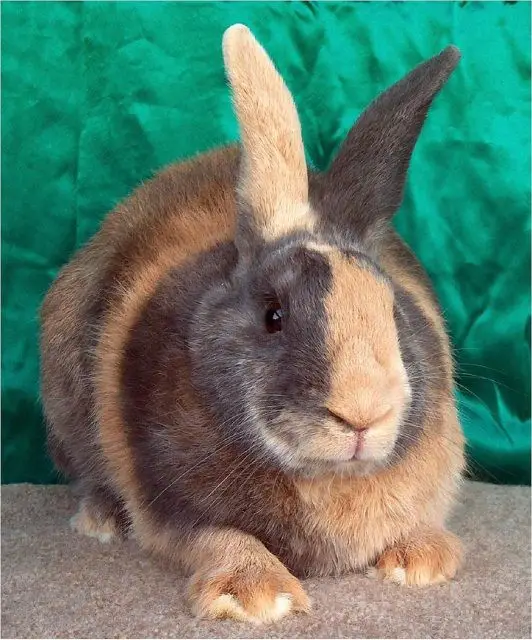
Harlequin Rabbit is a healthy breed and is not in any way affected by the disease. Possibly the reason for this is the result of very strict breeding like a rabbit for show. The most that Harlequin Rabbits may be affected with are common fur pests like mites, ticks, and fleas. This is because these are pests are naturally found in their environment.
Usually, rabbits are not immune to common rabbit diseases. You must monitor your rabbit’s health and temperament. Any change could be due to an illness, and thus, it must see a vet at once.
As early as your pet can open its eyes and move out of its nest, take it to the vet for standard vaccinations and health tests. These tests will assess the health and development of your pet and will help avoid certain diseases that affect young rabbits.
Also, there are rabbits with sensitive digestive systems and thus could be prone to different health conditions that affect the digestive tract such as enteritis, bloat, and stasis. These conditions may affect rabbits, which are about two months old.
Hold your rabbit and check for ear or fur parasites such as mites, fleas, and ticks. These may be easily removed by applying pest control powders and oils. Most of the time, rabbits with these pests have poor hygiene and have poorly-kept cages.
Always check your pet for any signs of illness such as poor appetite, nasal and eye discharges, diarrhea, and vomiting. Watch out for unsteady gait, restlessness, a grating of the teeth, and sleeping for extended periods because these can be signs of severe illnesses.
De-worming is also important in the care of Harlequin Rabbits. This is a major concern, especially with rabbits that are caught from the wild or are bred from wild parents. All breeds must be dewormed, and this should be done in the spring and fall. Use a pea-sized amount of de-worming paste and gently place the paste inside the rabbit’s mouth. It will lick the medicine and swallow it. Follow the dose according to the product container for the best results.
Dental Care
A vital part of a rabbit’s health is caring for its teeth. A Harlequin Rabbit will naturally grow its teeth, and sometimes these can grow very fast. You must make sure that the rabbit’s teeth are healthy and won’t overgrow. Rabbits have a natural way to do this, and it is usually chewing on anything like hay and wood.
Remember that teeth that grow too much can grow into their mouths and jaws, which can cause terrible pain and affect the way they eat. You can help your rabbit by giving it hay as it files down its teeth naturally by chewing.
Place pieces of wood, wooden baskets, or other safety accessories that can file a rabbit’s teeth. You may also take your pet to the vet or dentist for proper care.
Spaying or Neutering
Because of the promiscuity of rabbits, you must control their ability to breed, especially for a captive-bred rabbit. Spaying and neutering should be done at a young age.
Some vets wait until the rabbits are six months old to be safe. Bucks may be neutered as young as three months. Consult your vet for the best ways for spaying and neutering your pet and to discuss aftercare as the rabbit needs time to recover from the surgery.
Grooming
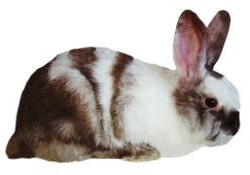
Harlequin Rabbits have moderately long fur and thus may need regular brushing and grooming. But no matter what color of Harlequin Rabbit you have, it will need regular grooming. Brush its fur to keep it clean, shiny, and free from pests.
Grooming should be done more frequently, especially during the molting period, to prevent wool blocks and to avoid fur ingestion. The fur is not digested, and it can accumulate in the digestive tract causing blockage and even dangerous complications if you don’t groom your rabbit’s coat.
If your rabbit is very dirty, you should never bath it because doing this may cause a lot of stress. You may use a damp towel to spot clean it. Just wipe the rabbit down with the towel and use a dry one to dry it afterward.
Another thing to check is your pet’s nails. Trim their nails monthly or file theme if you can. Also, check its mouth for overgrown teeth. If you are not comfortable with cutting or filing your pet’s nails and checking its mouth, ask the vet to do this for you.
The vet has special tools to trim the nails safely and properly, and they also have ways to check its mouth and inspect the teeth. The rabbit’s big ears must be cleaned and checked for pests and blockage.
Comparable Breeds

The harlequin rabbit is comparable to the Dutch rabbit. Both have large bodies, but the harlequin is larger and heavier compared to the Dutch, which is a mini breed. The Dutch rabbit can live up to 8 years, but with the care of its human owners, rabbits can live longer. The Dutch rabbit is compact, happy, calm, easy-going and energetic. This rabbit loves to be with families, singles, and seniors even for pet owners who live in small apartments.
Availability – Where to Get One?

The cost of purchasing a Harlequin Rabbit may depend on whether you are buying from a breeder or a retailer. The price also varies whether you are getting a rabbit for a pet or show. The price may change depending on the gender, size, coat color, coat quality, and overall appearance. Lovely harlequin rabbits are also available in shows and competitions.
When looking for a reliable breeder, you must be sure that you are getting a healthy rabbit and without any type of genetic disorder. Purchase only from reliable breeders who raise captive-bred Harlequin Rabbits.
Harlequin Rabbits may also be seen in trade fairs and farm events to showcase large and healthy rabbits for coat and meat. Shows and contests also feature this breed and may be sponsored by the ARBA or by other local associations and clubs.
How to Care for a Harlequin Rabbit
Caring for a Harlequin Rabbit is just like caring for other breeds. You must be sure that it has the correct diet, housing, and take it to a vet for proper medical treatment and dental treatments.
The main food of captive-bred rabbits is hay. You may also use pellets made for rabbits, vegetables, and fruits for a well-rounded rabbit diet. Give rabbits food found in their natural habitats like grasses, twigs, weeds, seeds, nectar, and fruits, but make sure that these are from organic sources.
Keep fresh water and hay in their cage. Hay helps keep their digestive tracts healthy, happy, and regular. Always place water in a large, heavy shallow dish so that your rabbit can drink from it. The dish is heavy, so it won’t be knocked over.
Take note that captive-bred rabbits can become a good pet only when you take time and effort to train it. It’s best if you train and interact with it daily. Also, rabbits are social and will need a companion. It’s best to get three or more so your pet can grow happy and healthy, with a good temperament.
FAQs
Should you take home a wild rabbit from the forest?
Don’t get a wild animal like a rabbit from the forest because you won’t be able to tame it, and you won’t have it as a pet. If you see an injured wild rabbit call animal services for help and avoid touching it because this may bite or scratch
Are Harlequin Rabbits endangered?
No, harlequin rabbits are not endangered. It is a commercially available rabbit that’s bred for show, fur, and meat. It is abundant in many farms and breeding areas all over the world.
Where do Harlequin Rabbits live?
You’ll rarely find the Harlequin Rabbit breed in the wild because these are domesticated breeds and are mostly found in breeding kennels, pet stores, and in human homes.
Are Harlequin Rabbits territorial?
Harlequin Rabbits, just like other rabbits, can be territorial when kept in a small enclosure. Males may become very aggressive to other males in the breeding season. They may bite, scratch, and kick their opponents to establish hierarchy and their territory.
How do you take care of baby Harlequin Rabbits?
If you’re breeding baby rabbits, place the kits in a comfortable and warm box or container. Feed them soft, pureed food to replace their mother’s milk and keep them warm. The container must have a lock so you can protect these from predators, especially from your house cat or pet dog. For wild baby rabbits, call animal services to have these rescued and properly cared for.
Can you leave a Harlequin Rabbits indoors out of its cage?
Just like allowing a rabbit to remain outdoors out of its cage, you may let a rabbit stay indoors but under your constant supervision. Use a portable perimeter fencing to cover areas that the rabbit can’t go. You must rabbit-proof your home before you let your rabbits free.
Can Harlequin Rabbits swim?
Yes, Harlequin Rabbits, like other rabbits, can swim but not as good as other rabbits. Also, rabbits don’t want water on their fur because this can stress them. So as much as possible, never bath your pet.
How do you tame a rabbit?
Don’t pet and tame a wild rabbit because this won’t be trained any matter you do. It may also bite you if it thinks that you are a threat. You may pet and tame a captive-bred rabbit instead. Although these rabbits are docile, these still need constant handling, playing, and interaction with their cage mates and from their owners.
Do you keep a Harlequin Rabbit’s cage indoors or outdoors?
This may depend on the space you have at home or your preference. You can place the cage of your pet indoors to protect it from rain or sun, but most indoor cages are small and may not be enough for a large Harlequin Rabbit. When the cage is kept outdoors, the rabbits may have to bear the cold, but at least they will have a large area to play.
Will a mother, Harlequin Rabbit, eat her young?
Some rabbit species will eat their babies. Experts say that the mother does this to protect their nest from predators; also, it is a way to eat and drink if food and fluids are unavailable. When you spot the mother Harlequin Rabbit eating her young in captivity, remove it from the litter or its nest and don’t allow it to breed again.
How do you clean a Harlequin Rabbit’s cage?
First, remove the rabbit and place it in another cage. Remove the pan for the droppings are found and dispose of the poop carefully. Use a hose and cleaning product and clean the cage walls, bottom, accessories, and all your rabbit’s toys. Make sure everything is dry before placing your pets back in.
Does it hurt when a Harlequin Rabbit jumps on you with its hind legs?
Yes, a Harlequin Rabbit is larger and thus have very sharp claws even on its hind feet. Although this breed is friendly and sweet, it can also become the opposite when it perceives you as a threat. Also, it can kick very hard with its hind feet, which can cause damage. The rabbit will do this if it feels threatened and to escape from predators.
Are Harlequin Rabbits bites dangerous?
Yes, Harlequin Rabbit bites may be dangerous because this may have rabies. Also, their teeth are huge and can easily tear off flesh leaving you with a deep wound.
Can you keep a Harlequin Rabbit as a pet?
Yes, you can keep it as a pet because it has a naturally friendly, docile and sweet temperament. It is a good pet for families but not for families with very small kids because of its size.
Can Harlequin Rabbits eat meat?
No, harlequins are herbivores, which means that these won’t eat meat, only plants, and commercial rabbit food. Harlequin rabbits will also eat tree parts like roots, bark, leaves, stems, seeds, flowers, twigs, and many more.
Do Harlequin Rabbits eat fruits and vegetables?
Yes, you can give your pet rabbit some fruits and vegetables. Aside from these, Harlequin Rabbits can also eat commercially-prepared pellets or rabbit food that have added nutrients that your pet will need for good health.
Can Harlequin Rabbits remain outdoors?
Yes, a pet Harlequin Rabbit may be allowed to remain outdoors, but you must rabbit-proof your yard before releasing it outdoors. Use perimeter fencing to limit the area where the rabbit can roam free. Be sure to bury the poles of the fence well to avoid escape.
What happens when the teeth of a rabbit grow longer?
When the teeth of the rabbit grow longer, these can pierce its mouth and lower gums, which leads to too much pain and may also affect the rabbit’s appetite. This is why your pet rabbit should visit the dentist to check for teeth overgrowth. You must also offer hay for the rabbit to chew on since this can slowly grind their teeth.
How often do rabbits need to go to the vet?
Rabbits should visit the vet at least once a year. Young rabbits must be vaccinated against some diseases, so they need to have an initial visit during the first weeks of life.
Are Harlequin Rabbits able to escape their cages?
Yes, despite their size, these rabbits can escape their cages. These can’t jump over their cages but are strong enough to knock it down and escape. Large rabbits are very good kickers and can kick their cages or fences to escape.
Do Harlequin Rabbits have good hearing?
Although the Harlequin Rabbit has smaller ears compared to other breeds, this rabbit has good hearing. Rabbits are born with excellent hearing to hear its predators or any threats from far away, and thus, it has time to jump and escape from any threat.
What do Harlequin Rabbits eat?
Harlequin Rabbits are herbivorous, and this means that they will eat only plants. They will eat all plant parts such as roots, bark, seeds, weeds, flowers, and leaves, but in captivity, these will eat commercial food like pellets.
Will Harlequin Rabbits eat their poop?
Yes, just like other rabbits, harlequin rabbits can eat their poop because these still have nutrients in them. After eating them once, they won’t eat their poop the second time. This weird behavior is common in all rabbit breeds.
Can you keep two or more Harlequin Rabbits inside a cage?
Yes, you can keep two or more harlequin rabbits in one cage as long as the cage is large enough to keep these large rabbits. Take note that the cage should be large, comfortable, and secure for all your pets to stay.
Can rabbits survive the cold?
Yes, rabbits can stay out in the cold and survive by foraging food that’s found under the snow. Rabbits can dig snow and eat roots, shrubs, berries, and other edible things.
Can rabbits see well in the dark?
Yes, rabbits like the harlequin have amazing vision, especially at night. This may be the reason why some species prefer to forage for food at night. Rabbits also have a good sense of smell and hearing to allow them to detect predators.
Are rabbit diseases harmful to humans?
Some rabbit diseases can affect rabbits, while some are harmful to humans. If your rabbit is sick, you must take it to the vet at once. Take note of the different signs of illnesses like poor appetite, sneezing, diarrhea, constipation, and any change in behavior. Take it to the vet for these symptoms.
Can you prevent a Harlequin Rabbit from eating his poop?
You can stop a rabbit from eating poop by removing the droppings right away when you see them pooping. But no matter what you do, these rabbits will still eat their poop because they know this still has nutrients in them.
Do you need a heater inside a Harlequin Rabbit’s cage?
In cold places, you can use a cage lamp for heat. But in extremely cold weather, a small portable heater would do. Place this near the rabbit cage to create a comfortable place for your pet to live in.
